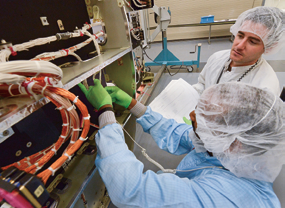Northrop Grumman builds and integrates the anti-jam communication payloads for the U.S. Air Force’s next-generation Advanced Extremely High Frequency (AEHF) satellites. Payloads consist of the complete set of processing, routing and control hardware and software that perform the satellite’s communications function, including critical features to protect the communications against interception or jamming threats.

Northrop Grumman technicians thread wiring and cabling through the fourth protected communications payload for the U.S. Air Force’s Advanced Extremely High Frequency satellite system. (Northrop Grumman photo.)
The company has built and delivered three payloads and (as of this writing) is currently integrating a fourth payload at its facilities in Redondo Beach, California. Northrop Grumman provides AEHF payloads to Lockheed Martin Space Systems, Sunnyvale, California, the system prime contractor.
Advanced EHF, the next generation of protected military satellite communications satellites, provides vastly improved global, survivable, highly secure, protected communications for strategic command and tactical warfighters operating on ground, sea and air platforms. The system also serves international partners including Canada, the Netherlands and the United Kingdom.
A single Advanced EHF satellite provides greater total capacity than the entire Milstar constellation that is currently on orbit. Individual user data rates will be improved 5x, and the higher data rates will permit two-way, jam-resistant transmission of tactical military communication such as real-time video, battlefield maps and targeting data.
In addition to its critical tactical mission, Advanced EHF also will provide the critical survivable, protected and endurable communications to National Command Authority including Presidential conferencing in all levels of conflict.
Each payload meets more than 3,000 specific requirements, which dictate a unique design delivering the flexible connectivity-on-demand needed to achieve swift, decisive outcomes based on information dominance. AEHF payloads are designed to be fully backward compatible with the Low Data Rate (LDR) and Medium Data Rate (MDR) capabilities of the previous generation of protected communication satellites, known as Milstar.
The unique AEHF payloads are the most advanced and complex communication payloads in the world to date. Each payload in the military satellite communications (MilSatCom) constellation acts as an on-board processed switchboard in the sky, with constellation interconnects provided through on-board satellite crosslinks, thus forming a truly global, flexible and protected communications network without the need for vulnerable overseas ground gateways or stations.
AEHF payloads include:
– Nearly one million lines of software code
– 25 computers
– Nearly 800 application-specific integrated circuits
– Almost 18,000 monolithic microwave integrated circuit chips of 70 unique designs
– More than 13,000 integrated microwave assemblies and hybrids of 50 unique designs
– 14 antennas
Advanced EHF provides the only truly jam-, detection- and interception-resistant military communications, capable of operating through all levels of conflict including nuclear war. Extremely High Frequencies, onboard digital processing and highly directional antennas reduce the probability of jamming and intercept, assuring secure, reliable communications for the warfighter.
Development of AEHF payloads leveraged a unique skill and technology base grown over three decades of engineering for the Low Data Rate and Medium Data Rate Milstar payloads.
Starting in 2002, Northrop Grumman poured these lessons learned, and unique engineering skills, into developing the AEHF payloads, each of which provides 10x the warfighter capacity of a MILSTAR II MDR payload at half the size and weight.
Each AEHF payload meets more than 3,000 specific requirements, weighs in excess of 3,600 pounds, and uses 6,000 Watts of power. Northrop Grumman delivered the first three payloads ahead of schedule in 2007, 2008 and 2009, respectively. And just recently, the company delivered an electronics unit that precisely positions a highly sophisticated suite of antennas for the U.S. Air Force’s fourth Advanced Extremely High Frequency (AEHF) satellite.

AEHF lab tests being conducted at Northrop Grumman.
The sophistication of AEHF’s communication system is unique. Payloads have interfaces to all portions of a global system-of-systems that provides tactical and strategic protected communications. An innovative blend of advanced, on-board digital signal processing hardware, firmware and software provides high throughput with flexibility to enable evolution.
The software-centric, configuration-table-uploadable payload design allows maximum flexibility in delivering protected communication for the nation’s defense now and for decades to come, as the location, complexion and communication-bandwidth demands of the battlefield evolve as they have multiple times in the last two decades of providing this capability operationally through the Northrop Grumman-built Milstar payloads.
• XDR—AEHF’s payload flight software represents the first-ever flight qualification of the new Extended Data Rate (XDR) capability.
– Using XDR and other advanced technologies and designs, AEHF will provide 10 times more communications capacity and six times higher channel data rates than the predecessor Milstar system that provides Low Data Rate (LDR) and Medium Data Rate (MDR) waveforms.
• Phased array antennas—another AEHF ‘first’—direct radio frequency beams electronically rather than by moving reflectors mechanically.
– This allows one array to do the job of many reflectors, giving the flexibility to point-on-demand in fractions of a second, greatly improving warfighter access.
– Each AEHF satellite payload has three phased array antennas, consisting of one uplink antenna and two downlink antennas.
– AEHF’s downlink phased array antenna, which sends signals to ground terminals, is the first of its kind to operate at 20 GHz in space.
– The uplink phased array antennas are the first of their kind to operate at 40 GHz in space.
• An advanced semiconductor material, Indium Phosphide (InP), is a new technology for some of the UPA antennas’ more than 10,000 monolithic microwave integrated circuits. InP ensures excellent low-noise, or clear signal, performance.



